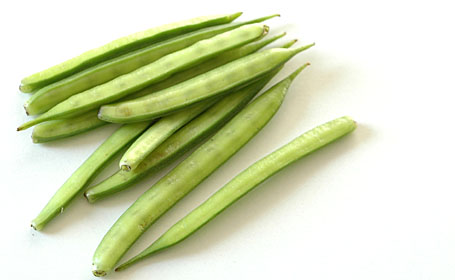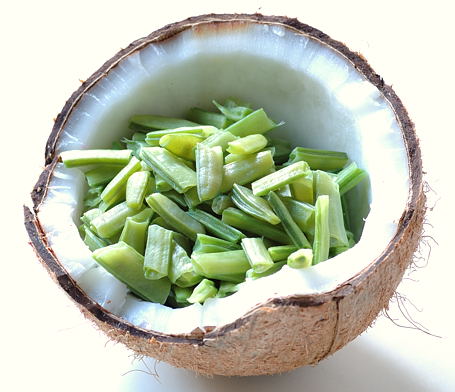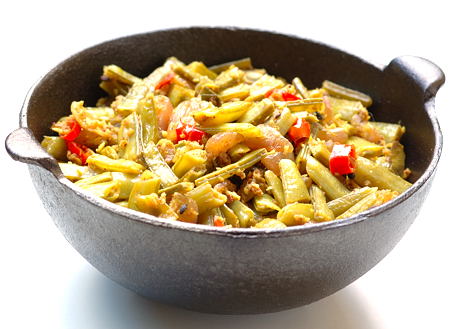
Gawar Beans (Mattikayalu, Cluster Beans)
Gawar beans seem to be purely Indian vegetables. I came to this conclusion only because I have never seen these beans in any other grocery places. Not Chinese, nor Thai, with whom we share many vegetables. Even though they are very common at Indian ritu bazaars (farmer markets), they are a rare find at Indian grocery shops here in US. I happen to like gawar beans very much. So whenever I see them, I buy a whole bunch, for at least two days’ curry-worthy. For the first-timers, the beans are easy to identify. They have a distinct flat appearance. Pale green and thin skinned ones with undeveloped seeds are best for cooking. Gawar beans are crunchier than green beans and have a slightly tougher texture, and can take a little more cooking without getting mushy. They are great simply blanched, stir-fried, or cooked with flavorful sauces, and could be served hot or cold.
For today’s meal, I seasoned the blanched gawar beans with fresh coconut and ripe red chillies. And added goda masala at the end. One tasty kura was ready for chapatis.

Fresh Coconut and Blanched Gawar Beans
Recipe:
Gawar beans – half pound, about two cups of cut beans
Red onion, finely sliced – half cup
Ripe red chillies, finely sliced – a tablespoon
Fresh coconut, grated – two tablespoons
Goda masala – one tablespoon
Turmeric and salt – ¼ teaspoon each, or to taste
Gawar beans:
String the beans, and pinch off the ends. Wash and cut or snap to one inch length pieces. Add them to boiling water. Cook for a minute or two and drain.
Seasoning:
In a wide skillet, heat a teaspoon of peanut oil.
Add a sprig of curry leaves and pinch each – cumin and mustard seeds.
When seeds start to pop, add onions and ripe red chillies. Saute to crisp.
Add the blanched gawar beans. Stir in coconut, goda masala, turmeric and salt.
Mix and then cover the skillet. Cook for about five minutes.
Serve hot. Gawar beans kura tastes superb with chapatis / rice and dal.

Gawar Bean Kura
notes:
Gawar beans are available, fresh and frozen at local Indian grocery shops, here in US.
From Telugu to English, Kura=Curry

What a coincidence 🙂 I made Gowar beans curry with just coconut.
Comment by Vandana — October 3, 2007 @ 12:17 pm
My gosh – I’m amazed to hear these are hard to find where you are. They seem to be the one vegetable that is always, but ALWAYS available at the Indian store (along with brinjals) here in San Francisco. I have not cooked with them as I don’t know quite what to do with them, but now I have an option.
Comment by Diane — October 3, 2007 @ 1:19 pm
Your pics continue to amaze me, each time I visit your site (though this is my first comment…to advertize my site…he he..shameless), but trully, they are amazing.
Comment by Shobana — October 3, 2007 @ 1:29 pm
I think curry is tamil, because we in Tamilnadu would have called this recipe as gawar beans curry!! Guess curry is a universal word now!
Comment by Rohini — October 3, 2007 @ 4:43 pm
rohini, curry is british..and kari is tamil!!! and yes, they stole it from tamil. damn them, they changed the spelling.
indira, didnt you make parupu usili with this beans earlier? i think its also possible to make poricha kootu with beans.
p.s. thanks for the comment…you made my day!
Comment by faustianbargain — October 3, 2007 @ 5:52 pm
Indira!
Your timing rocks! I just bought some gawar beans at the indian store in seattle, this sounds like the perfect recipe for it! 🙂
Comment by Kaykat — October 3, 2007 @ 7:23 pm
Hi Indira,
I love these beans too… Bud sadly they aren’t available here… I have the sun-dried ones called “vathal” in Tamil, which I occasionally use in sambhar etc. But well, it isn’t the same…
I also had a comment on “Food Blog Desam” which you and Mathy maintain.. I should start by saying that I love the aggregator and it is great to be able to see all that is happening in the indian food blog scenario without visiting each blog… Moreover, I have discovered a bunch of great blogs through it….
Recently, I have been seeing many non-blogs up there, news papers like NYTimes, WPost, Toronto star and other random web-sites… They seem to take up the space and not add much to the aggregator…. I was wondering if there was a particular reason for adding them to the list of blogs…
Thanks again and I hope this didnt come off as mean… Just a thought and I throughly appreciate your efforts…
Hema
Comment by Hema — October 3, 2007 @ 8:14 pm
Hey Indira you won’t believe I made them yesterday with the Goda masala and coconut too and will blog about it in a day or two.:) I think this is Telepathy.Yours looks very tempting.
Comment by Madhuli — October 3, 2007 @ 8:47 pm
Indira,
Yes, these are certainly pure Indian veggies..I have a hard time finding them in NJ..
Koora superb!
Comment by Chandrika — October 3, 2007 @ 8:49 pm
Wonderful looking curry Indira! Since Vinayaka Chathurthi I was missing you regular posts but now feeling very happy to see them more frequently. Thanks for this recipe! Whenever I think about these Gawar beans (I guess its the kothavarangai we get here) I think about Mor Kuzhambu. Both make a great pair!
Comment by Nirmala — October 3, 2007 @ 10:25 pm
hi indira, this is called kothamara in malayalam. used to be a staple in the hostels i stayed and the canteen of mathrubhumi newspaper where i had worked for an year. developed quite an aversion after that ! but, later, i returned to love it even more !!! try slicing it fine and make a stir-fry with seasoning of mustard, black gram (uzhunnu parippu), chillies, curry leaves and lots of coconut. we also use it in sambar.
rohini, curry or kari, is also a malayalam word, denoting any side dish, mainly with gravy, used more commonly in the southern parts of kerala. up north, from thrissur onwards, it is koottan. the word was absorbed by the british and became an all-representative of what is known as the indian cuisine in britain.
Comment by renu — October 4, 2007 @ 5:48 am
Hi Indira,
Would you post the telugu or english names for badal phool, dagad phool, and nagkeshar?
thanks
Comment by padmaja — October 4, 2007 @ 5:50 am
Dear Indira,
I just now read the article in rediff.com featuring your blog. Congrats and best wishes.
Comment by Timepass — October 4, 2007 @ 5:53 am
Wow,nice Photograhy and interesting recipe using cluster beans…I will make with our tamilnadu style curry powder,coconut,simple method and you have used goda masala…:))But some masala items I Dont know in your list…I will get answer if you reply Padmaja’s comment!!!Thanx for the recipe!!
Comment by Rajeswari — October 4, 2007 @ 7:06 am
Hia,
It would be a great help if you could clarify ingredients in the Goda Masala, particularly dagad phool, nagkeshar etc.
Ur site is my Indian Recipe Book. Any plans for publishing a cook book? Well, if yes I making an advance booking. Wishing u the Best.
Nikki
Comment by Nikki — October 4, 2007 @ 9:06 am
Hi Indira garu,
Nice recipe! Looks mouth-watering! Here in the Indian grocery stores in NY/NJ we have these beans almost year round.
YOUR tiny SKILLET/OR THE VESSEL WITH THE GUVAR BEANS CURRY LOOKS SO CUTE. Looks like cast iron…?? Did u cook the curry in that? Can you please advise me where can I purchase a similar one. Indira garu, u really have a great collection of cooking pans/skillets and gadgets!
I’ll watch out for more info’ on this cute little skillet that u used for this guwar beans.
Thanks in advance,
Swarna.
Comment by Swarna — October 4, 2007 @ 9:37 am
Vandana: That’s a nice coincidence.:)
Lucky you Diane. You live in a state we call “Little Indiaâ€ÂÂ.:)
They used to be year round. Now I rarely find them here at local Indian grocery shops.
Shobana: Thanks and best wishes for your new site.
FB: Poricha kootu, it is then for tomorrow’s meal. Thank you for the suggestion.
“My Labyrinth” post from your blog was my favorite post.
Come back soon, please.
Kaykat::)
Hema: Glad to hear that you find FBD useful. Thanks for your query.
About other links you mention – We have added RSS feed of few newspaper food sections that we read regularly to FBD.
FBD is not only a public service, it’s also a way for me and Mathy to keep up with what’s going on in outside world foodwise. We believe it’s important to have that knowledge. We are also planning to add Indian newspapers like “The Hindu, I.E” etc as soon as they provide this RSS feature for food sections.
Madhuli: same pinch then.:)
Chandrika: Me too. I rarely see them here.
Nirmala: I missed you too. The weather turned to gloomy here and I needed a break for few days. But here I am again.:)
Renu: I will give it a try and thank you for the curry explanation. I learned a lot.
Padmaja:
Nagakeshar is Nagasagaralu,
Dagad phool is Kallupachi,
Badal phool/Star anise is Anaspuvvu in Telugu.
Thanks Timepass!
Rajeswari: you are welcome. Goda masala also taste good with vegetables.
Nikki: I will publish the photos of these ingredients this coming weekend.
No plans at all, and thanks for your interest.
Swarna: Yes, it’s a cast-iron kadhai. I bought it at a local asian shop.
Comment by Indira — October 4, 2007 @ 5:51 pm
such great photos!!!!!!
you are good….very good….
Comment by mahek — October 7, 2007 @ 10:06 am
hi Indira.i live in lagos -nigeria and have been a fan of ur site for quite a while now. i did not post a comment earlier simply because i was too busy downloading all the yummy and simply delicious stuff you and all the other girls so very kindly post. i like cooking and your simple and BEAUTIFULLY presented recipes have been instrumental in increasing my interest even more. thanks a ton and keep the palate ticklers rolling in.i an an avid pickle maker and eater and as my fam. says i eat more of these than actual food–prick me and the vinegar will flow. so do post a few of the same pleeeeeeeeaaaasssseeeee.looking forewrd to a line in reply—-sonali.
Comment by sonali lokur — October 11, 2007 @ 3:53 am
Please clarify what does naskeri (chipiti miri) mean, the difference between normal jeera and shajira
what is jaipatri? and a much clearer translation of dagad phool, what family of condiment does this ingredient belong to. Has it got an aniseed flavour?
kind regards
Comment by m pereira — May 10, 2008 @ 7:34 am